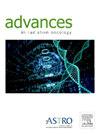铼-皮肤癌治疗非黑色素瘤皮肤癌的疗效、安全性和患者报告的结果:EPIC-Skin研究的1年结果
IF 2.7
Q3 ONCOLOGY
引用次数: 0
摘要
目的:氦皮肤癌治疗(SCT)是一种创新的、无创的放射性核素治疗非黑色素瘤皮肤癌(NMSC)的方法,只需一次门诊治疗。一项全球性、多中心、单臂、上市后4期临床研究建立,以评估OncoBeta铼- sct治疗NMSC的疗效、安全性、美容效果和患者报告的结果。该报告详细介绍了预定的12个月中期结果,包括毒性、美容和患者报告的结果。方法与材料活检证实的I期或II期基底细胞癌或鳞状细胞癌(SCC)病变深度≤3mm,面积≤8cm2。患者将铼- sct作为一种树脂应用于粘贴在病变部位的粘接箔上,剂量为50 Gy至最深点。根据治疗方案,12个月后使用修改后的实体瘤反应评价标准评估疗效,计划的主要终点测量24个月的完全缓解。次要终点包括患者报告的生活质量(皮肤癌指数)、治疗舒适度、美容(视觉评估量表;1:差-10:不可见)和毒性(CTCAE v5.0)。结果140例患者185个病灶的完全缓解率为94.1%(174/185),部分缓解率为3.2%(6/185)。其余病变分别为2.2%(4/185)和0.5%(1/185)的进展性或稳定性病变。生活质量较基线平均提高10.55 (95% CI, 3.79, 17.31)点(100分制)。在治疗期间没有患者报告疼痛或不适。大多数患者(88%,129/147)如预期发展为放射性皮炎,其严重程度主要为1级或2级,并迅速消退。患者最常见的12个月毒性是1级低色素沉着(60.4%;78/129),而此时没有3级或4级毒性的发生率。患者和临床报告的美容视觉评估量表结果分别为8.1和7.7(10分制)。这项为期12个月的EPIC-Skin中期分析表明,铼- sct是一种有效且耐受性良好的治疗浅基底细胞癌和SCC病变的方法,具有良好的安全性、美观性和患者满意度。这些结果强调了铼- sct作为NMSC的单疗程、无创治疗的实用性,为有功能或外观考虑和/或合并症的患者提供了一种安全、有效和高效的手术替代方法。本文章由计算机程序翻译,如有差异,请以英文原文为准。
Efficacy, Safety, and Patient Reported Outcomes of Rhenium-Skin Cancer Therapy for Non-Melanoma Skin Cancer: 1-Year Results from the EPIC-Skin Study
Purpose
Rhenium-skin cancer therapy (SCT) is an innovative, noninvasive radionuclide treatment for nonmelanoma skin cancer (NMSC), which is administered in a single outpatient treatment session. A global, multicenter, single-arm, phase 4 post-marketing clinical study was established to evaluate efficacy, safety, cosmesis, and patient-reported outcomes of OncoBeta rhenium-SCT for NMSC. This report details scheduled 12-month interim results, including toxicity, cosmesis, and patient-reported outcomes.
Methods and Materials
Eligible patients had biopsy-proven stage I or II basal cell carcinoma or squamous cell carcinoma (SCC) lesions ≤3 mm deep and ≤8 cm2 in area. Patients were administered rhenium-SCT as a resin applied to adhesive foil affixed to the lesion/s, with a dose of 50 Gy to the deepest point. As per the treatment protocol, efficacy was assessed using modified Response Evaluation Criteria in Solid Tumors criteria after 12 months, with planned primary endpoint measuring complete response scheduled for 24 months. Secondary endpoints included patient-reported quality of life (Skin Cancer Index) treatment comfort, cosmesis (visual assessment scale; 1: poor -10: not visible), and toxicity (CTCAE v5.0).
Results
Response rates for 185 treated lesions from 140 patients were 94.1% (174/185) complete response, and 3.2% (6/185) partial response. The remaining lesions were classified as progressive or stable disease in 2.2% (4/185) and 0.5% (1/185), respectively. Quality of life improved by a mean 10.55 (95% CI, 3.79, 17.31) points (100-point scale) from baseline. No patients reported pain or discomfort during treatment. Most patients (88%, 129/147) developed radiation dermatitis as expected, which was predominantly grade 1 or 2 in severity and resolved rapidly. The most common 12-month toxicity in patients was grade 1 hypopigmentation (60.4%; 78/129), while there was no incidence of grade 3 or 4 toxicities at this time. Patient- and clinician-reported cosmesis visual assessment scale outcomes were broadly favorable at 8.1 and 7.7, respectively (10-point scale).
Conclusions
This 12-month interim analysis of EPIC-Skin indicates rhenium-SCT is an effective and well-tolerated treatment for shallow basal cell carcinoma and SCC lesions, yielding favorable safety, cosmesis, and patient-satisfaction outcomes. These outcomes underscore the utility of rhenium-SCT as a single-session, noninvasive treatment for NMSC, offering a safe, effective, and efficient alternative to surgery for patients with functional or cosmetic considerations, and/or comorbidities.
求助全文
通过发布文献求助,成功后即可免费获取论文全文。
去求助
来源期刊

Advances in Radiation Oncology
Medicine-Radiology, Nuclear Medicine and Imaging
CiteScore
4.60
自引率
4.30%
发文量
208
审稿时长
98 days
期刊介绍:
The purpose of Advances is to provide information for clinicians who use radiation therapy by publishing: Clinical trial reports and reanalyses. Basic science original reports. Manuscripts examining health services research, comparative and cost effectiveness research, and systematic reviews. Case reports documenting unusual problems and solutions. High quality multi and single institutional series, as well as other novel retrospective hypothesis generating series. Timely critical reviews on important topics in radiation oncology, such as side effects. Articles reporting the natural history of disease and patterns of failure, particularly as they relate to treatment volume delineation. Articles on safety and quality in radiation therapy. Essays on clinical experience. Articles on practice transformation in radiation oncology, in particular: Aspects of health policy that may impact the future practice of radiation oncology. How information technology, such as data analytics and systems innovations, will change radiation oncology practice. Articles on imaging as they relate to radiation therapy treatment.
 求助内容:
求助内容: 应助结果提醒方式:
应助结果提醒方式:


